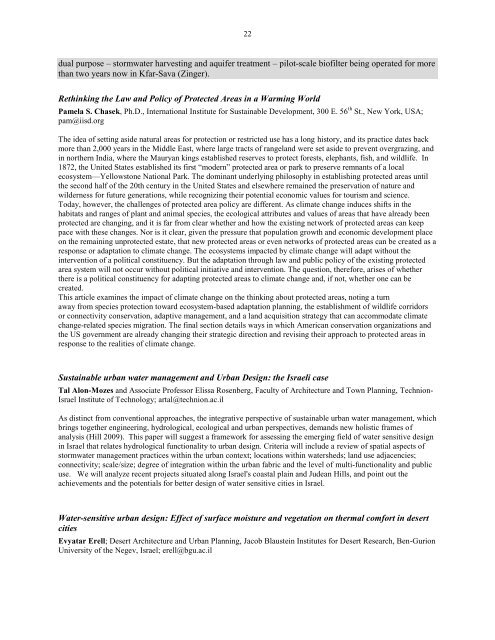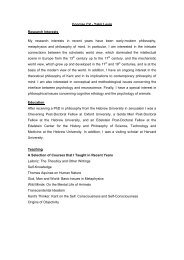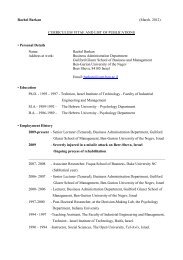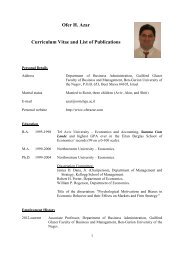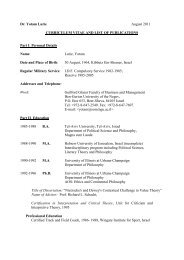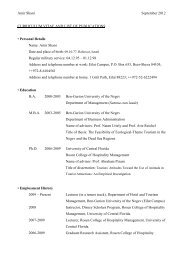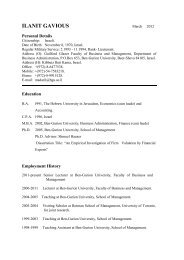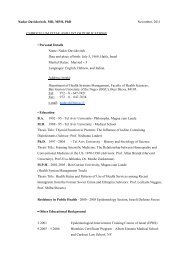Book of Abstracts
Book of Abstracts
Book of Abstracts
You also want an ePaper? Increase the reach of your titles
YUMPU automatically turns print PDFs into web optimized ePapers that Google loves.
22<br />
dual purpose – stormwater harvesting and aquifer treatment – pilot-scale bi<strong>of</strong>ilter being operated for more<br />
than two years now in Kfar-Sava (Zinger).<br />
Rethinking the Law and Policy <strong>of</strong> Protected Areas in a Warming World<br />
Pamela S. Chasek, Ph.D., International Institute for Sustainable Development, 300 E. 56 th St., New York, USA;<br />
pam@iisd.org<br />
The idea <strong>of</strong> setting aside natural areas for protection or restricted use has a long history, and its practice dates back<br />
more than 2,000 years in the Middle East, where large tracts <strong>of</strong> rangeland were set aside to prevent overgrazing, and<br />
in northern India, where the Mauryan kings established reserves to protect forests, elephants, fish, and wildlife. In<br />
1872, the United States established its first “modern” protected area or park to preserve remnants <strong>of</strong> a local<br />
ecosystem—Yellowstone National Park. The dominant underlying philosophy in establishing protected areas until<br />
the second half <strong>of</strong> the 20th century in the United States and elsewhere remained the preservation <strong>of</strong> nature and<br />
wilderness for future generations, while recognizing their potential economic values for tourism and science.<br />
Today, however, the challenges <strong>of</strong> protected area policy are different. As climate change induces shifts in the<br />
habitats and ranges <strong>of</strong> plant and animal species, the ecological attributes and values <strong>of</strong> areas that have already been<br />
protected are changing, and it is far from clear whether and how the existing network <strong>of</strong> protected areas can keep<br />
pace with these changes. Nor is it clear, given the pressure that population growth and economic development place<br />
on the remaining unprotected estate, that new protected areas or even networks <strong>of</strong> protected areas can be created as a<br />
response or adaptation to climate change. The ecosystems impacted by climate change will adapt without the<br />
intervention <strong>of</strong> a political constituency. But the adaptation through law and public policy <strong>of</strong> the existing protected<br />
area system will not occur without political initiative and intervention. The question, therefore, arises <strong>of</strong> whether<br />
there is a political constituency for adapting protected areas to climate change and, if not, whether one can be<br />
created.<br />
This article examines the impact <strong>of</strong> climate change on the thinking about protected areas, noting a turn<br />
away from species protection toward ecosystem-based adaptation planning, the establishment <strong>of</strong> wildlife corridors<br />
or connectivity conservation, adaptive management, and a land acquisition strategy that can accommodate climate<br />
change-related species migration. The final section details ways in which American conservation organizations and<br />
the US government are already changing their strategic direction and revising their approach to protected areas in<br />
response to the realities <strong>of</strong> climate change.<br />
Sustainable urban water management and Urban Design: the Israeli case<br />
Tal Alon-Mozes and Associate Pr<strong>of</strong>essor Elissa Rosenberg, Faculty <strong>of</strong> Architecture and Town Planning, Technion-<br />
Israel Institute <strong>of</strong> Technology; artal@technion.ac.il<br />
As distinct from conventional approaches, the integrative perspective <strong>of</strong> sustainable urban water management, which<br />
brings together engineering, hydrological, ecological and urban perspectives, demands new holistic frames <strong>of</strong><br />
analysis (Hill 2009). This paper will suggest a framework for assessing the emerging field <strong>of</strong> water sensitive design<br />
in Israel that relates hydrological functionality to urban design. Criteria will include a review <strong>of</strong> spatial aspects <strong>of</strong><br />
stormwater management practices within the urban context; locations within watersheds; land use adjacencies;<br />
connectivity; scale/size; degree <strong>of</strong> integration within the urban fabric and the level <strong>of</strong> multi-functionality and public<br />
use. We will analyze recent projects situated along Israel's coastal plain and Judean Hills, and point out the<br />
achievements and the potentials for better design <strong>of</strong> water sensitive cities in Israel.<br />
Water-sensitive urban design: Effect <strong>of</strong> surface moisture and vegetation on thermal comfort in desert<br />
cities<br />
Evyatar Erell; Desert Architecture and Urban Planning, Jacob Blaustein Institutes for Desert Research, Ben-Gurion<br />
University <strong>of</strong> the Negev, Israel; erell@bgu.ac.il


